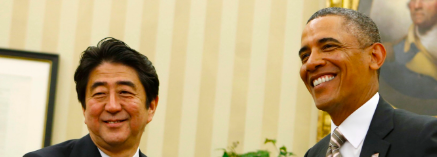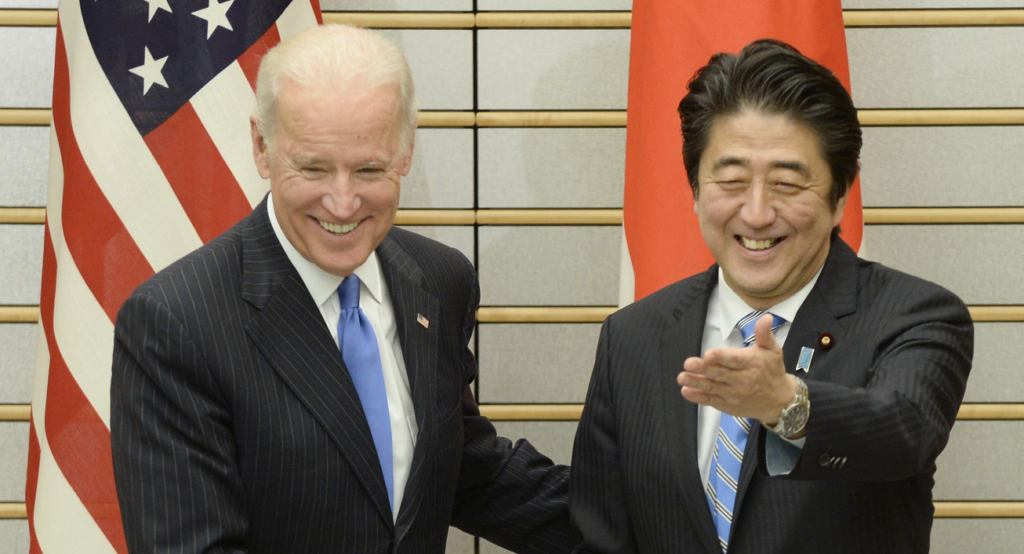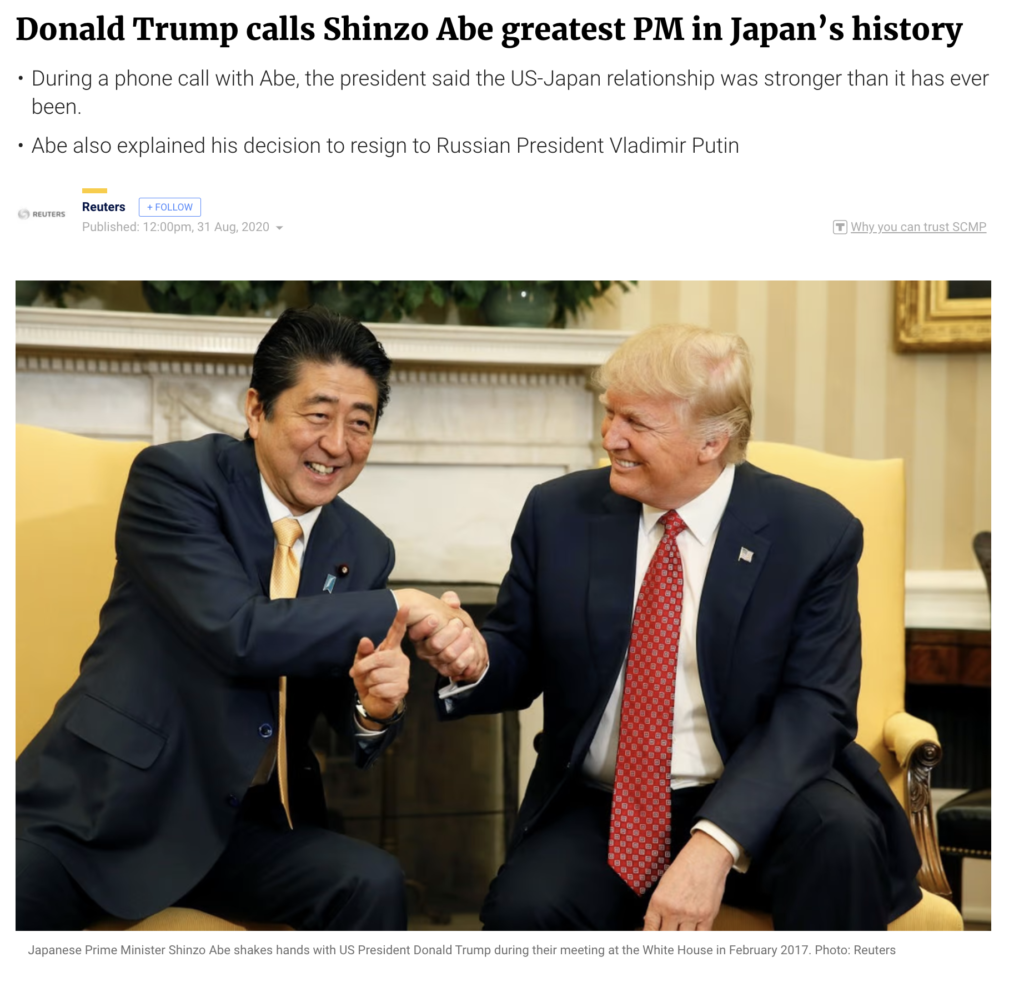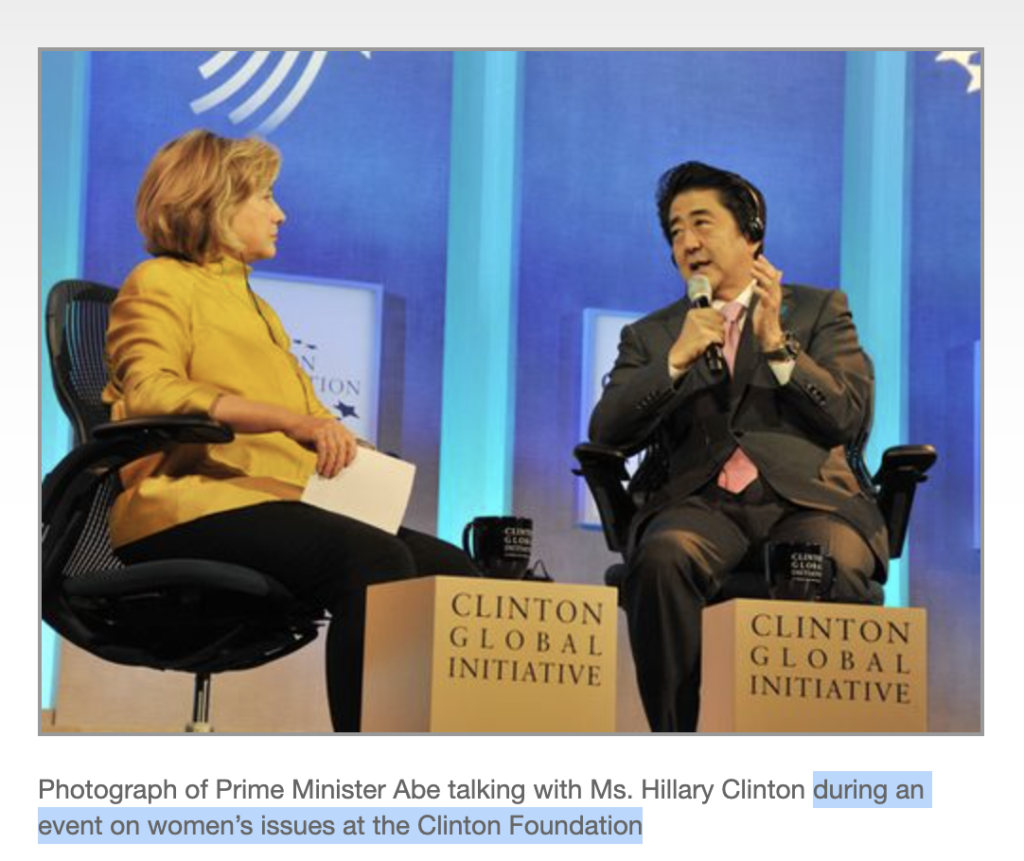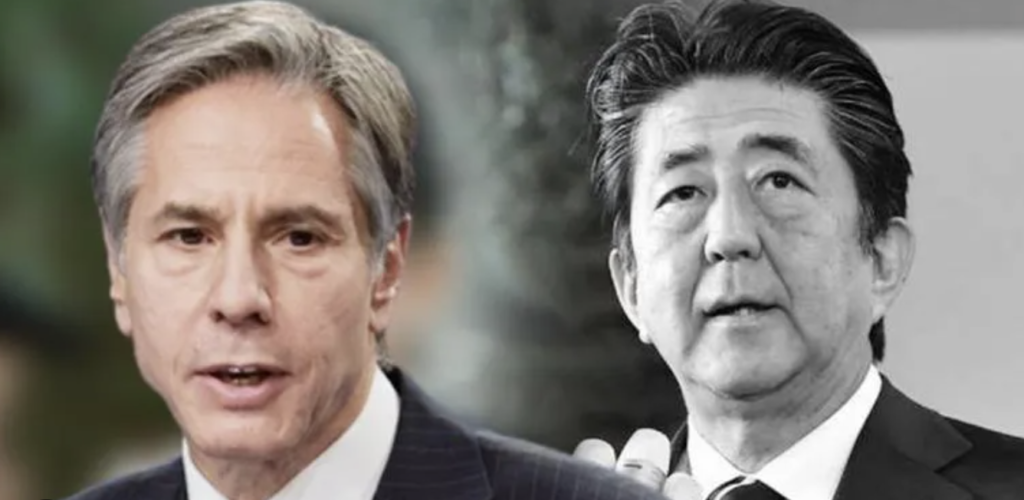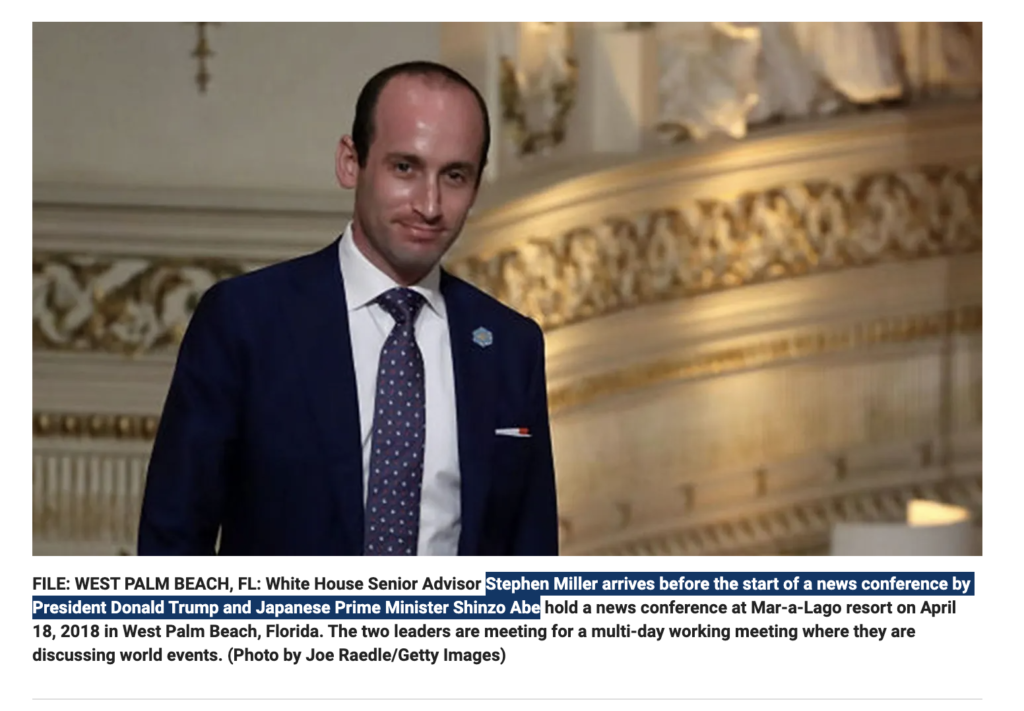Who Was Shinzo Abe?
And why was he so beloved by Democrats and Republicans, from Biden to Trump and all sides of the political divide in Washington?
Abe symbolizes of one of the darkest secrets of US foreign policy in Asia: America’s decades-long alliance with, and support for, the South Korean and Japanese far-right. The Unification Church that brought him down was the super-glue that bound these three parties together and eventually created the US-run DMZ Empire.
BY TIM SHORROCK
When Abe Shinzo, Japan’s longest service prime minister, was assassinated on July 8, 2022, he and his ruling LDP party were praised relentlessly by the U.S. political establishment in Washington.
“A champion of the Alliance between our nations and the friendship between our people,” declared President Biden, who immediately ordered that flags on federal buildings be flown at half mast – a rare step of respect for a fallen foreign leader. David Sanger, the well-connected national security reporter for the New York Times, called Abe “the most transformational politician in Japan’s postwar World War II history.” By “reinterpreting” Japan’s US-imposed constitution, Abe committed Japan for the first time to the “collective defense” of its Pacific allies, Sanger offered.
Secretary of State Antony Blinken, who worked closely with Abe during his second term as part of President Obama’s national security team, called the two-time Prime Minister a “man of vision” who “did more than anyone to elevate the relationship between the United States and Japan to new heights.” Hillary Clinton, apparently non-plussed over Abe’s stubborn refusal to apologize for Japan’s wartime abduction of thousands of “comfort women” from Korea, mourned Abe as a “champion of democracy” and a “firm believer that no economy, society, or country can achieve its full potential if women are left behind.”
And over in MAGA country, where only the manly men survive, Abe was viewed as the world’s most successful nationalist and known as the “Trump before Trump.” From the cult’s leader on down the chain, the praise was thick. “Really BAD NEWS FOR THE WORLD!” Donald Trump virtually shouted on his account at Truth Social, his money-losing alternative to Twitter. Abe, the first foreign leader to meet with him as president and a frequent visitor to Mar-A-Lago, “will be greatly missed,” he added. “There will never by another like him.” Meanwhile, Stephen Miller, Trump’s ghoulish immigration adviser and the architect of his family separation policies at the Mexican border, called Abe a “great leader of his nation,” while Jack Posobiec, the notorious rightist, declared that Abe had “been one of the fiercest anti-communists in all of Asia and was never afraid to stand up to the CCP.”
But many Japanese felt differently about Abe.
Days after Abe’s assassination, the Japanese media lifted a longtime taboo about reporting on the ruling Liberal Democratic Party’s deep links to the Unification Church, the anticommunist religious cult founded in 1954 (with assistance from the Korean CIA) by the self-proclaimed Korean messiah Sun Myung Moon. Soon, these shady relationships, and the politics behind them, became the number one issue in Japan, obscuring much of the positive coverage that usually follows a political assassination.
Days before his attack, the assassin Tetsuya Yamagami had written a letter accusing Abe of being one of the most influential supporters of the church and blaming Abe’s famous grandfather, Nobusuke Kishi, for promoting the controversial sect. As most Japanese know but few Americans are aware, Kishi was the Minister of Commerce for the Tojo cabinet that declared war on the United States in 1941 (more details in my Nation article below).
In 1945, Kishi was jailed by the US occupation forces as a Class A war criminal for his activities running the Japanese colonies in Manchuria and northern Korea during the war. After being freed by US authorities in 1951, he rose through the ranks of the LDP to become prime minister, when he presided over the renewal of the US-Japan security treaty in 1960. According to one report, Kishi began visiting the Unification Church in 1970 after building ties with its International Federation for Victory Over Communism.
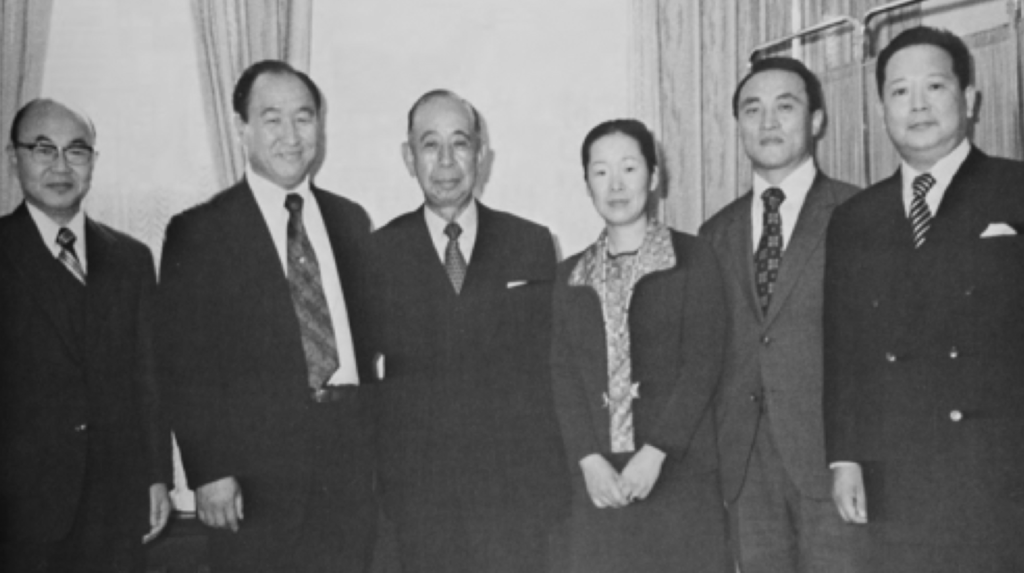
As the Japanese press kept digging after the assassination, it soon became clear that Abe had inherited his grandfather’s love for the Moonies. Clips soon surfaced of Abe delivering a video message in 2021 to the Universal Peace Federation, an arm of the Unification Church, praising its focus on “family values” and telling members that “we should be wary of so-called social revolutionary movements with narrow-minded values.” The tabloid Nikkan Gendai compiled a list of 112 LDP lawmakers, including 34 current and former cabinet ministers, who were closely associated with the church and the anticommunist Federation. Many Japanese were shocked in August when Prime Minister Fumio Kishida appointed a new cabinet that includes over 20 lawmakers linked to the Moonies. All of this resonated strongly with the Japanese public.
For years, the Unification Church and its zealous followers had been accused of using heavy-handed tactics and intimidation to force donations from church members. Many Japanese were sympathetic to the assassin’s complaint that his mother, a fervent believer in Reverend Moon, handed over to the church much of her family’s savings – over $750,000 in total. In July, a network of 300 lawyers representing families of church members said it has received 34,000 complaints related to “lost” money totalling more than 120 billion yen (about $890 million) since 1987.
The church’s political campaigns in support of Abe and the LDP have further colored his image. The Mainichi newspaper reported that the Moon-backed International Federation for Victory over Communism has distributed videos supporting the constitutional amendments that would alter the peace constitution, a lifelong goal of Abe’s. During the fall, Japan’s ANN reported that records had been found of Sun Myung Moon “telling followers in 1989 that the Abe faction of the LDP was the center of their efforts to gain influence over Japanese politics.”
As Japanese digested the revelations about the Unification Church, opposition grew to Kishida’s plans for a state funeral for Abe. Polls conducted in August by Kyodo News found that 53 percent of Japanese wanted the state funeral cancelled and that a stunning 85 percent said politicians should cut their ties with the Unification Church and its front groups. When the state funeral finally took place on September 27th, with Vice President Kamala Harris attending for Biden, thousands of people protested in the streets.
US press dropped the ball on the Moonies
Outside of an initial report in the Washington Post, however, the US press has stayed completely away from reporting on Abe’s ties to the Unification Church. That is strange in part because the Moonies have been controversial in the United States since the 1970s, when it was at the center of a congressional bribery scandal known as Koreagate. Starting in the 1980s, the Moon empire has had a profound impact on US politics through its ownership of the Washington Times, which was created as a right-wing alternative to the Post. But Abe and the LDP, of course, were hardly alone in their admiration for the Moonies.
Over its history, the church has cultivated relationships with several US presidents, including Richard Nixon, Ronald Reagan and George H.W. Bush. In September 2021, Trump was paid a princely sum to praise the Unification Church for a virtual event in Seoul that was organized by Hak Ja Han Moon, Sun Myung Moon’s widow and the co-founder of the church’s Universal Peace Federation (later, police said “the suspect decided to kill Abe after watching a video of that event.”) In Seoul, meanwhile, Moon’s Universal Peace Federation organized a public memorial for Abe on August 12 that was attended in person by former UN secretary General Ban Ki-moon and Harry Harris, the retired admiral and former US ambassador to Seoul. Both Trump and Mike Pence sent messages to the gathering, with Pence calling on world laders to take action against “religious persecution,” the Moon-affiliated Segye Ilbo reported.
Listen to my hour-long interview on Shinzo Abe and US backing of the LDP. “Who Was Shinzo Abe And Why Was He Assassinated?” on WORT/Madison. For a deep dive into Abe’s attempt to rewrite Japan’s wartime history, read this interview with the brilliant historian Alexis Dudden in The New Yorker. And for a compendium of essays about Abe’s legacy in Japan, see this analysis in Asia-Pacific Journal from David MacNeill.
With that as background, let’s turn back to Abe. As I’ve long argued, Abe’s LDP is the most obsequious pro-American political party in the world. Since coming to power in 1955, it has been seeking to transform Japan into a military power and do away with Article Nine of its US-imposed constitution, which rejected war as a means to settle international disputes. In 2015, after years of relentless pressure from the CIA, the Pentagon, and Washington’s think tanks, Abe pushed through the most important change to the constitution by turning Japan, in my view, into “America’s proxy Army.” Here’s the article I wrote about that disgraceful event. It goes deeply into Abe’s past and his ties to Japan’s far-right. Strap in; it’s a deep dive.
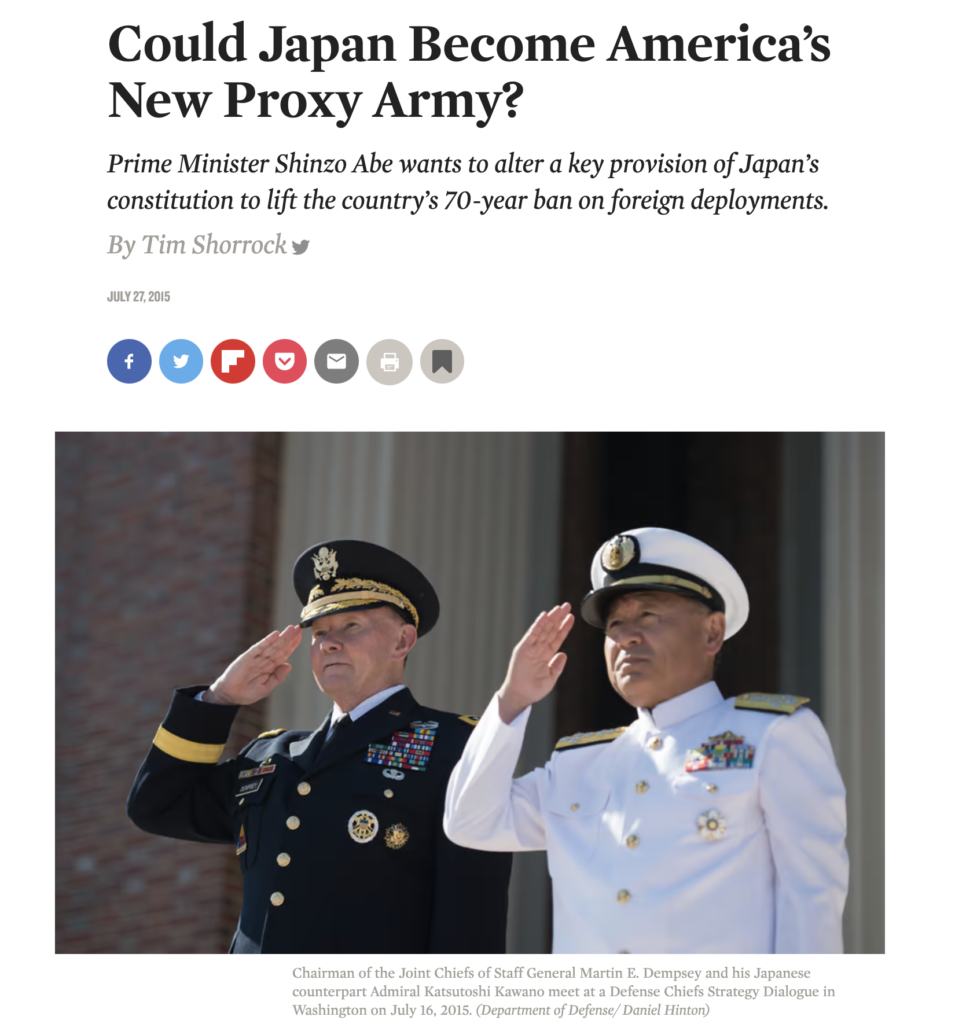
Note: The question in the title of this article is now moot. Japan, as a result of the parliamentary change described here, is now a virtual proxy army for the United States. The unprecedented joint exercises between the U.S. and Japanese air forces last summer would never have taken place without the changes Abe brought to Japan.
In the summer of 2015, Japan was shaken by the largest anti-war demonstrations since the late 1960s, when millions of students, workers, and ordinary citizens turned out to try to block their government’s collaboration with the US war in Vietnam. The issue this time was the plan by Prime Minister Shinzo Abe to alter a key provision of Japan’s peace constitution to allow Japan’s “Self Defense Forces” to take part in overseas military operations for the first time since World War II.
That happened on July 16, 2015, when Abe’s Liberal Democratic Party pushed through a critical vote in the Japanese Diet to lift its 70-year ban on foreign deployments and, as The New York Times reported, give “Japan’s military limited powers to fight in foreign conflicts.” This week, the controversial legislation is being debated by Japan’s Upper House. The Democratic Party of Japan, the largest opposition party, faces an uphill battle to stop the bill despite the growing number of people expressing their opposition in the streets.
Abe’s victory will transform Japan—with its surprisingly large, tech-driven military-industrial complex—into America’s new proxy army. It builds on recent changes to US-Japanese “guidelines” on strategic cooperation that, as the Times has reported, will “expand the reach of Japan’s military—now limited to its own defense—allowing it to act when the United States or countries American forces are defending are threatened.” The agreement was hammered out in April, when Abe met at the White House with President Obama, and was clearly on the administration’s mind when the LDP claimed victory in the Diet.
“We certainly welcome Japan’s ongoing efforts to strengthen the alliance and to play a more active role in regional and international security activities, as reflected in our new guidelines for US-Japan defense cooperation,” State Department spokesman Robert Kirby told reporters. And as Foreign Policy pointed out last week, the development “could be very good news for U.S. defense contractors.”
But the dramatic shift in Japan’s military posture is strongly opposed by its neighbors, particularly in Korea and China. A recent poll showed 62 percent of Japanese respondents opposed the security legislation, the Japan Times reports. And as protests by citizens, academics, constitutional scholars, and even government officials mount, some analysts believe the right-wing Abe has badly overstepped and may have even dug his own political grave by flouting Japan’s strong commitment to pacifism in overseas affairs.
So who is this prime minister who has won the trust of the Obama administration while earning the enmity of the growing majority of its own citizens? Here’s everything you need to know about “our guy” in Tokyo and his party’s long ties to the United States.
Abe’s LDP was put in power with the help of the CIA and became one of the most subservient political allies the United States has ever had.
Here is how I described the LDP’s history as America’s underling in Asia in The Nation in 2003:
[Japan’s LDP] was the junior partner to the United States during the cold war, when Washington created an alliance of anticommunist dictators who supported American foreign policy while repressing their own people…. The symbiotic relationship between Washington and Tokyo was forged in 1948, when the United States “reversed course” in its occupation of Japan to focus on the containment of communism. Almost overnight, US policy shifted from punishing Japanese bureaucrats and industrialists responsible for World War II to enlisting them in a global war against the Soviet Union and China.
This was an easy shift for the corporate and financial conglomerates who backed Japan’s cruel war, according to Muto Ichiyo, a Japanese writer and activist who worked closely with the US anti-war movement in the 1960s and 1970s.
“The part of Japanese imperialism which was made powerless after the defeat in the war wanted, of course, to revive itself,” Muto once explained to me in Tokyo. “But they knew perfectly well that the situation had changed. They knew also that fighting against America again would be both impossible and purposeless. So they adopted a very clear-cut strategy: Japan will concentrate on the buildup of the economic base structure of imperialism, while America will practically rule Asia through its military forces.”
The late, great Chalmers Johnson once compared Japan’s postwar LDP prime ministers to the East German leaders Walter Ulbricht and Erich Honecker and their obeisance to the USSR. “Just as the two satraps of the German Democratic Republic faithfully followed every order they ever received from Moscow, each and every Japanese prime minister, as soon as he comes into office, get on an air plane and reports to Washington,” Johnson wrote in Blowback, his classic account of the Cold War’s impact on US foreign policy.
The LDP’s CIA ties were documented by Times reporter Tim Weiner in his excellent history of the CIA, Legacy of Ashes. As summarized by the great Tokyo journalist Jake Adelstein, Weiner’s Japan chapter “details how in post-war Japan, the CIA, using large amounts of cash, reinstated former war criminal Kodama Yoshio and hand-picked one of Japan’s Prime Ministers–in order to suppress communist/socialist movements…and ensure that Japan didn’t go red.” Adelstein himself investigated the LDP’s mob ties to the Japanese yakuza, who were often enlisted by the LDP to crush antiwar and labor protests.
Abe, who was previously Prime Minister from 2006 to 2007, represents the most right-wing faction of the pro-American LDP, and speaks for a virulent minority of politicians and civil society groups who idealize Japan’s World War II empire in East Asia and want to restore its greatness in a military alliance with the United States.
According to Gavan McCormack, the eminent Australian historian of modern Japan:
Abe…was in fact the most radical of all Japanese post-1945 leaders. He declared his…mission as Prime Minister to be nothing less than the “recovery of independence” (dokuritsu no kaifuku). His term was marked by denialism (of war responsibility, notably for the comfort women and the Nanjing massacre) and ultra-nationalism (the insistence on the need to rewrite Japan’s history and its textbooks so as to make people proud and fill them with patriotic spirit)…. [He] strived to turn the bilateral relationship into a “mature” alliance, reinforcing Japanese military subordination and integration under US command and taking preliminary steps towards revising the constitution to facilitate that process.
With his latest triumphs in the Diet, Abe has fulfilled his most cherished dreams—and those of his own family. As Abe likes to remind audiences, he is the grandson of Nobusuke Kishi, one of the original members of the LDP who was Japan’s prime minister from 1957 to 1960. During World War II, Kishi was minister of commerce and industry in the wartime Tojo Cabinet and labeled by the US occupation as a “Class A” war criminal for helping run Japan’s colonial empire in Manchuria. And, as Weiner’s book documents, he was funded for years by the CIA. Abe, whose father also served at the highest reaches of the LDP, is very proud of Kishi, as The Wall Street Journal reported upon his second election as premier in December 2014:
Shinzo Abe recalls sitting on his grandfather’s lap as a young boy 55 years ago. They listened to protesters in the streets outside who opposed the older man’s push to rebuild Japan’s military after World War II, Mr. Abe says. Soon after, Mr. Abe’s grandfather, Nobusuke Kishi, resigned as Japan’s prime minister, his aims for his country unfulfilled. Now, as Japan’s most powerful prime minister in years, Mr. Abe is looking to complete some of his grandfather’s unfinished business.
The “unfinished business” of an expanded US-Japan military alliance has been pushed heavily by US national security officials from both the Dem0cratic and Republican parties for decades.
Last April, just before he retired as Secretary of Defense, Chuck Hagel made the link between Abe’s remilitarization and the changes in Japan’s constitution very explicit, telling Nikkei, Japan’s premiere financial newspaper, that the Obama administration “welcomes Japan’s efforts to play a more proactive role in the alliance, including by re-examining the interpretation of its constitution relating to the right of collective self-defense.”
The US position on the alliance was spelled out in 2012, in a joint statement issued by Washington’s most important military think-tank, the Center for Strategic and International Studies, or CSIS (which, in addition to being heavily funded by defense contractors, receives a considerable amount of money from the Japanese government).
The CSIS panel was chaired by the leading ideologists of the Make-Japan-Our-Proxy-Army Movement (yes, I made that up), Richard Armitage, a military veteran of the Reagan and Bush II administrations, and Joseph Nye, a Democratic policy-maker and former Pentagon official at Harvard’s Kennedy School. In 2012, they convened a panel of Asian “experts” from the Reagan, Clinton, and Bush administrations that included Asia hardliners Victor Cha and Michael Green, both now of Georgetown University, and David Asher, a senior fellow at the Center for New American Security, the military think-tank that’s supplied half of Obama’s appointments to the Pentagon (Armitage chairs its board of advisers).
Suffice to say, these are the current “wise men” of the American foreign policy establishment, and they had strong words for Abe and their new proxy military. Here were their instructions to Tokyo:
Japan should expand the scope of her responsibilities to include the defense of Japan and defense with the United States in regional contingencies. The allies require more robust, shared, and interoperable ISR capabilities and operations that extend well beyond Japanese territory. It would be a responsible authorization on the part of Japan to allow U.S. forces and JSDF to respond in full cooperation throughout the security spectrum of peacetime, tension, crisis, and war
In the body of the report, Armitage and Nye directly address the question of constitutional change in Japan, as if the United States, which did impose the 1945 constitution, continues to have the right to tell its defeated colony what to do.
The irony…is that under the most severe conditions requiring the protection of Japan’s interests, our forces are legally prevented from collectively defending Japan. A change in Japan’s prohibition of collective self-defense would address that irony in full…. Prohibition of collective self-defense is an impediment to the alliance…. It would be a responsible authorization to allow our forces to respond in full cooperation throughout the security spectrum of peacetime, tension, crisis, and war.
On July 13, Abe got that change through his Diet. Now it only has to pass the Upper House, and it becomes law. When it does, Japan—with assistance from the United States—will have taken a decisive step away from 70 years as a pacifist nation.
Which brings me back to Jake Adelstein, one of very few foreign reporters in Japan who’ve kept the tradition of investigative reporting alive. In a highly trafficked article in the Daily Beast, Adelstein said that Abe had badly over-reached in his zeal to make Japan part of the US military order in East Asia, and could fall as a result.
The popularity of his cabinet is sinking, the majority of the population now opposes the legislation, [and] over 90 percent of Japanese academics, and former prosecutors as well, have condemned the proposed legislation as unconstitutional. The media is turning on him. Even heavy hitters within his own Liberal Democratic Party are voicing disapproval. Its former secretary general, Makoto Koga, called the Abe regime “dark and creepy” in a recent interview.
A poll by Nippon TV saw disapproval ratings for the Abe government rising higher than its approval for the first time since he assumed power in December 2012. Support for the cabinet is 39 percent; disapproval 41 percent. Some 59 percent of those polled oppose passage of the Legislation for Peace and Security (aka the War Bill). Only 24 percent actually supports the bills. It may be the beginning of the end of his reign.
Let’s hope so.
